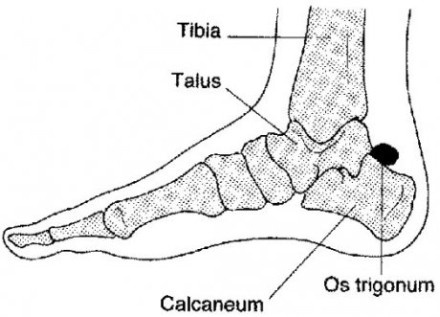
Os trigonum
This extra bone only causes problems if the affected foot is pointed downwards regularly. When this bony prominence is crushed between the tibia and the heel bone, the tissue surrounding the os trigonum can become trapped leading to inflammation and swelling. This condition is known as os trigonum syndrome.
The symptoms include pain at the back of the ankle and tenderness over the ankle bone.
The area to the front of the Achilles tendon can be painful to the touch and the bony prominence may be palpable. Pain will be present on pointing the foot downwards. Some swelling around the ankle area may be present.
The symptoms can present like an ankle or Achilles tendon problem, therefore diagnosis is made by x-ray where the extra bone will be evident.
Once the diagnosis of os trigonum syndrome is made, rest is advised. Continuing activity will only aggravate the condition. Ice should be applied every few hours, not directly to the skin but wrapped in a towel, to help with pain and reduce inflammation. Anti-inflammatory medication may be prescribed by your doctor if the pain is severe. Immobilisation by a walking boot to restrict ankle movement may also relieve symptoms.
Conservative treatment can work for the majority of cases. However if you are a professional athlete or symptoms are not relieved by the above treatment, surgery may be needed. During surgery, the os trigonum is removed completely. This will make no difference to the foot movement or stability as it is an accessory bone. A splint will need to be worn for two weeks following surgery. Following the splint removal an extensive course of physiotherapy will be required for 2-3 months to regain muscle strength, stability and full range of movement to the ankle and leg.
For more Physiotheraphy news click here.